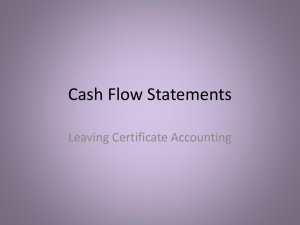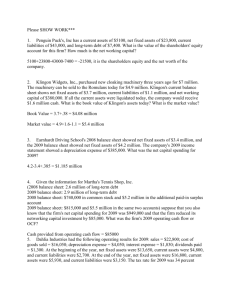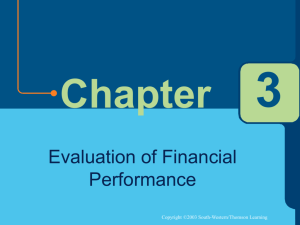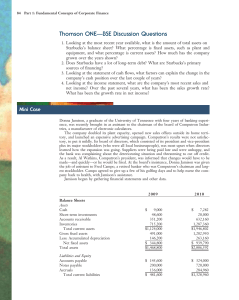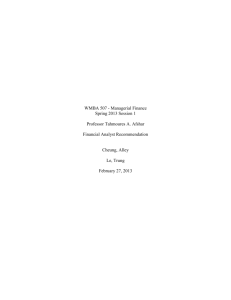Exam 1, Spring 2013
advertisement
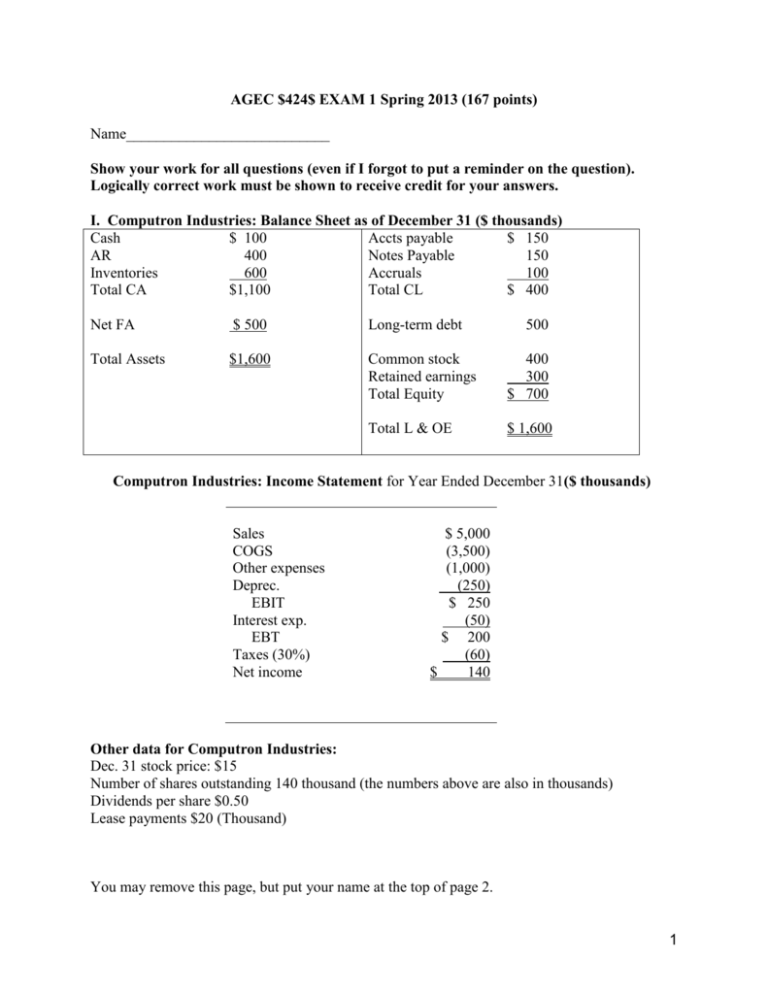
AGEC $424$ EXAM 1 Spring 2013 (167 points) Name___________________________ Show your work for all questions (even if I forgot to put a reminder on the question). Logically correct work must be shown to receive credit for your answers. I. Computron Industries: Balance Sheet as of December 31 ($ thousands) Cash $ 100 Accts payable $ 150 AR 400 Notes Payable 150 Inventories 600 Accruals 100 Total CA $1,100 Total CL $ 400 Net FA $ 500 Long-term debt 500 Total Assets $1,600 Common stock Retained earnings Total Equity 400 300 $ 700 Total L & OE $ 1,600 Computron Industries: Income Statement for Year Ended December 31($ thousands) Sales COGS Other expenses Deprec. EBIT Interest exp. EBT Taxes (30%) Net income $ 5,000 (3,500) (1,000) (250) $ 250 (50) $ 200 (60) $ 140 Other data for Computron Industries: Dec. 31 stock price: $15 Number of shares outstanding 140 thousand (the numbers above are also in thousands) Dividends per share $0.50 Lease payments $20 (Thousand) You may remove this page, but put your name at the top of page 2. 1 Name_______________________ 1. (38 points) Calculate ratios for Computron Industries for use in comparison to the following industry averages. Show your work in the Computron Industries box. Ratio Industry Computron Industries Evaluate briefly and then support If you don’t show your work in this average your statement by comparing to column you don’t get the points. the industry average. Current Ratio 1.6x Evaluate liquidity: Quick Ratio 0.6x Debt ratio (TL/TA) 50% Times Interest Earned 7.5x Inventory turnover 8x Days sales outstanding 40 days Fixed Asset turnover 5x Total assets turnover 2.0x Profit margin (ROS) Return on total assets (ROA) 3.0% Return on equity (ROE) 12% Price-Earnings 13x Market to Book 2.0x Acts pay. Def. 20 da. Evaluate debt level: Evaluate asset management Evaluate profitability: 6% Evaluate market ratios: 15.4 da. Don’t evaluate. Use the above data for questions 2 through 5. 2 2. (12 points) Construct the extended Du Pont equation for both Computron and for the industry. Then analyze the component breakdown of the company's ROE in comparison to the industry (say something about each component). 3. (4 points) Which is more responsible for the deviation of Computron’s ROE from the industry average: cost control, asset management, or debt management? Explain. 4. (8 points) Show a side by side comparison of the cash conversion cycle for Computron with the industry. Use the CCC to analyze working capital management for Computron in comparison to the industry (say something about each component). Say which is best and why? 5. (4 points) Based on the ratios and information in questions 1-4, point out red flags and major successes for Computron. 3 6. (10 points). Jill’s Wigs Inc. had the following balance sheet last year: Last Cash Accounts rec. Inventory Fixed assets Total assets $ 800 450 950 34,000 $36,200 Factor 1stPass Last Fact. 1st Pass Accounts payable $ 350 Accrued wages 150 Notes payable 2,000 Mortgage 26,500 Common stock 3,200 Retained earnings 4,000 Total liabilities and equity $36,200 Jill has just invented a non-slip wig for men which she expects will cause sales to double, increasing after-tax net income to $1,000. She was at 80% of capacity last year. Will Jill need any outside capital if she pays no dividends? If so, how much? Show the forecast balance sheet above and your final answer and supporting calculations below. 7. (12 points) You are given the following selected financial information for The Blatz Corporation. Income Statement Balance Sheet Ratios COGS $750 Cash $250 ROS 10% Net Income $160 Net Fixed Assets $850 Current Ratio 2.3 Inventory Turnover 6.0 ACP 45 days Debt Ratio 49.12% Calculate the following items and show your work in the space provided below. Sales: Total Liab.: Inventory: LT Debt: Accts Rec: Equity: Current Assets: ROA: Total Assets: Current Liabilities: ROE: 4 8. (30 points) Forecast AFN with a 40 % sales increase; at 90% of capacity last year; any additional funds will come from Notes payable, or a surplus will reduce notes payable. The interest rate is 10%. Round to the nearest whole dollar. Show Sales factor _______ And capacity calculation ___________ Last Sales -VC -FC EBIT -interest EBT -Taxes (40%) NI -Div (45%) Add. RE Cash AR Inv CA NFA TA AP Accr. Notes CL Bonds Stock RE TL+E Factor 1st Pass Feedback 2nd Pass 40,000 -20,000 -15,000 5,000 -600 4,400 -1,760 2,640 -1188 1452 1,000 6,000 9,000 16,000 13,000 29,000 5,000 2,000 2,000 9,000 4,000 4,000 12,000 29,000 Below show calculations and label: AFN for each pass, total AFN after two passes and additional interest expense calculation. 5 9. (5 points) Inflation is expected to be 5% next year and a steady 7% each year thereafter. Maturity risk premiums are zero for one year debt but have an increasing value for longer debt. One-year government debt yields 9% whereas two-year debt yields 11%. a. What is the real risk-free rate and the maturity risk premium for two-year debt? b. Forecast the nominal yield on one- and two-year government debt issued at the beginning of the second year. Show work here for a and b: 10. (3 points) Adams Inc. recently borrowed money for one year at 9%. The pure rate is 3%, and Adams’ financial condition warrants a default risk premium of 2% and a liquidity risk premium of 1%. There is little or no maturity risk in one-year loans. What inflation rate do lenders expect next year? Show work here: 11. (2 points) The income statement is intended to inform the reader of: a. the overall financial condition of the firm at a point in time b. how much the firm has earned during an accounting period c. how much income has been distributed to shareholders d. the cash flow generated by the firm over a period of time 12. (2 points) Which of the following does not appear on the income statement? a. Cost of Goods Sold b. Depreciation Expense c. Accumulated Depreciation d. Earnings Before Interest and Tax e. Gross Margin 13. (2 points) Holding all other variables constant, an increase in EAT can be caused by a decrease in: a. depreciation expense b. the cost ratio c. the tax rate d. both a & c e. a, b, & c are correct. 14. (2 points) The income statement line item that shows the performance of operating activities without consideration of financing is a. Net Income b. EBIT c. EBT d. Total Assets 6 15. (2 points) Which of the following does not appear on the right hand side of the balance sheet? a. Current Liabilities b. Accounts Receivable c. Retained Earnings d. Long-Term Debt e. Total Equity 16. (2 points) ________ indicate the firm’s capacity to meet its debt obligations, both short term and long term. a. Liquidity ratios b. Asset management ratios c. Debt management ratios d. Profitability ratios 17. (2 points) The ratio group most likely to be used to indicate a firm’s ability to meet short-term financial obligations would be: a. liquidity ratios b. financial leverage ratios c. activity ratios d. profitability ratios 18. (2 points) Under the DuPont system, the return on assets is equal to: a. the product of the gross profit margin and inventory turnover b. the sum of the debt-equity ratio and the return on sales c. the product of the return on sales and total asset turnover d. the product of the return on sales, total asset turnover, and equity multiplier e. none of the above 19. (2 points) Which of the following is not a short-term debt instrument? a. Commercial paper b. Common stock c. Money market securities d. Treasury bills 20. (2 points) Which organization typically helps a company market new securities? a. Commercial bank b. Insurance company c. Investment bank d. Mutual fund 21. (3 points) Find the debt ratio of a firm with total liabilities equal to $800,000 and net worth equal to $2,400,000. Show work below: a. .33 b. .50 c. .75 d. .25 e. .67 7 22. (3 points) CVD, Inc. has an equity multiplier of 2. What is CVD’s stockholders’ equity if total liabilities are $100,000? Show work below: a. b. c. d. $100,000 $150,000 $200,000 $50,000 23. (3 points) How much cash does Gray Computer Co. have if the firm has a current ratio of 2.5, a quick ratio of 1.2, and current liabilities of $12,000? Gray’s sales are $98,000 and its average collection period is 40 days. (Assume 365 days per year.) Show work below: a. b. c. d. $3,660 $14,440 $10,740 None of the above 24. (3 points) Three years ago a piece of equipment was purchased for $10,000. Assuming an eight-year life and straight-line depreciation, financial statements for the third year would show: Show work below: a. depreciation expense of $3,000 on the income statement and accumulated depreciation of $3,000 on the balance sheet b. depreciation expense of $1,250 on the income statement and accumulated depreciation of $3,000 on the balance sheet c. depreciation expense of $1,250 on the income statement and accumulated depreciation of $3,750 on the balance sheet d. depreciation expense of $1,250 on the income statement and accumulated depreciation of $1,250 on the balance sheet 25. (3 points) Selected accounts are listed below. How much is the firm’s operating income? Show work below: Accrued payroll $ 2,000 Sales 45,000 Cost of goods sold 26,000 Interest expense 1,000 Expenses (other than interest) 8,000 a. b. c. d. $8,000 $10,000 $9,000 $11,000 8 26. (3 points) Wessel Corp. plans to sell 1,000 units in 2005 at an average sale price of $45 each. Cost of goods sold will be 40% of the sale price. Depreciation expense will be $3,000, interest expense $2,500, and other expenses will be $4,000. Wessel’s tax rate is 20%. What will Wessel Corp.’s net income be for 2005? Show work below: a. b. c. d. e. $3,500 $6,800 $14,000 $16,400 $28,400 27. (3 points) The following items are components of a firm’s balance sheet. How much is the firm’s working capital (net working capital)? Show work below: Cash $ 2,000 Long-term debt $ 10,000 Inventory $ 12,000 Owners’ equity $ 62,000 Accounts payable $ 8,000 Accruals $ 1,500 Accumulated depreciation $ 6,000 Accounts receivable $ 14,000 a. $14,500 b. $2,500 c. $18,500 d. $12,500 9

